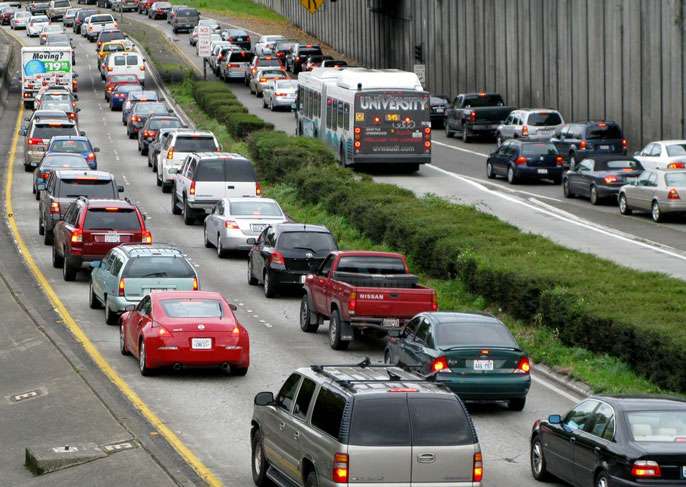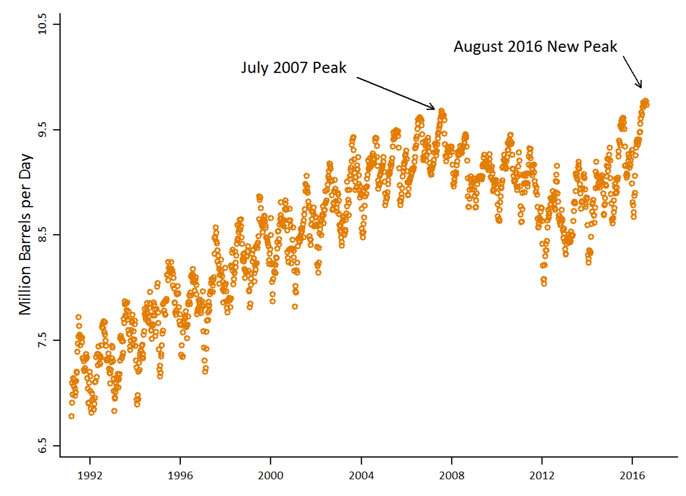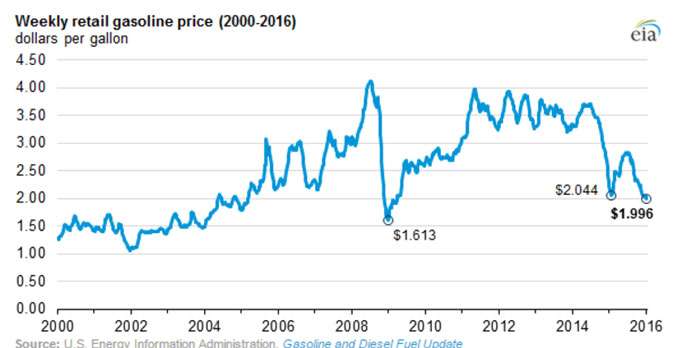US gasoline consumption is higher than ever

August was the biggest month ever for U.S. gasoline consumption. Americans used a staggering . That's more than a gallon per day for every U.S. man, woman and child.
The new peak comes as to many. In 2012, energy expert Daniel Yergin , "The U.S. has already reached what we can call 'peak demand.'" Many others . The U.S. Department of Energy in 2012 that U.S. gasoline consumption would steadily decline for the foreseeable future.
This seemed to make sense at the time. U.S. gasoline consumption had declined for five years in a row and, in 2012, was a million barrels per day below its July 2007 peak. Also in August 2012, President Obama had just aggressive new fuel economy standards that would push average vehicle fuel economy to 54 miles per gallon.
Fast forward to 2016, and U.S. gasoline consumption has increased steadily four years in a row. We now have a new peak. This dramatic reversal has important consequences for petroleum markets, the environment and the U.S. economy.
How did we get here? There were a number of factors, including the the Great Recession and a spike in gasoline prices at the end of the last decade, which are unlikely to be repeated any time soon. But it should come as no surprise. With incomes and low gasoline prices, Americans are back to buying big cars and driving more miles than ever before.

The Great Recession
The slowdown in U.S. gasoline consumption between 2007 and 2012 occurred during the worst global recession since World War II. The dates the Great Recession as beginning December 2007, exactly at the beginning of the slowdown in gasoline consumption. The economy remained anemic, with unemployment above 7 percent through 2013, just about when gasoline consumption started to increase again.
Economists have in of that there is a robust positive relationship between income and gasoline consumption – when people have more to spend, gasoline usage goes up. During the Great Recession, Americans traded in their vehicles for more fuel-efficient models, and drove fewer miles. But now, as incomes are increasing again, Americans are with , and driving .
Gasoline prices
The other important explanation is gasoline prices. During the first half of 2008, gasoline prices increased sharply. It is hard to remember now, but U.S. gasoline prices during the summer of 2008 above US$4.00 gallon, driven by crude oil prices that had topped out above $140/barrel.

These $4.00+ prices were short-lived, but gasoline prices nonetheless remained steep during most of 2010 to 2014, before falling sharply during 2014. Indeed, it was these high prices that contributed to the decrease in U.S. gasoline consumption between 2007 and 2012. Demand curves, after all, do slope down. Economists have shown that Americans are getting to gasoline prices, but there is still a strong negative relationship between prices and gasoline consumption.
Moreover, since gasoline prices plummeted in the last few months of 2014, Americans have been buying gasoline like crazy. Last year was the for U.S. vehicle sales, with trucks and SUVs leading the charge. This summer Americans took to the roads in record numbers. The U.S. average retail price for gasoline was $2.24 per gallon on August 29, 2016, the . No wonder Americans are driving more.
Can fuel economy standards turn the tide?
It's hard to make predictions. Still, in retrospect, it seems clear that the years of the Great Recession were highly unusual. For decades U.S. gasoline consumption has gone up and up – driven by rising incomes – and it appears that we are now very much back on that path.
This all illustrates the deep challenge of reducing fossil fuel use in transportation. U.S. electricity generation, in contrast, has become considerably greener over this same period, with enormous . Reducing gasoline consumption is harder, however. The available substitutes, such as electric vehicles and biofuels, are expensive and not necessarily less carbon-intensive. For example, electric vehicles can actually in states with mostly coal-fired electricity.

Can new fuel economy standards turn the tide? Perhaps, but the new "footprint"-based rules are yielding fuel economy gains than was expected. With the new rules, the fuel economy target for each vehicle depends on its overall size (i.e., its "footprint"); so as Americans have purchased more trucks, SUVs and other large vehicles, this relaxes the overall stringency of the standard. So, yes, fuel economy , but much less than it would have without this mechanism.
Also, automakers are hard, arguing that low gasoline prices make the standards . Some lawmakers have raised . The EPA's comment window for the standards' ends Sept. 26, so we will soon have a better idea what the standards will look like moving forward.
Regardless of what happens, fuel economy standards have a fatal flaw that fundamentally limits their effectiveness. They can increase fuel economy, but they don't increase the cost per mile of driving. Americans will drive miles in 2016, . Why wouldn't we? Gas is cheap.
More information: Meghan R Busse et al. Are Consumers Myopic? Evidence from New and Used Car Purchases, American Economic Review (2013).
Samaneh Babaee et al. How Much Do Electric Drive Vehicles Matter to Future U.S. Emissions?, Environmental Science & Technology (2014).
Journal information: American Economic Review , Environmental Science & Technology
Source: The Conversation
This article was originally published on . Read the .
![]()




















